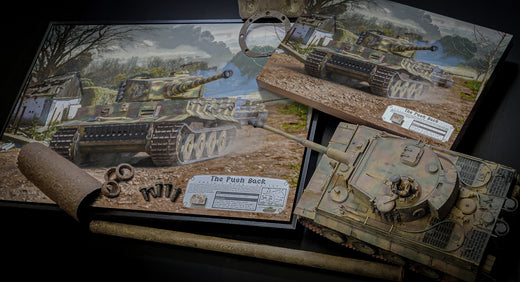This Fine Art Print by Artist Craig Tinder depicts the final days of Panzerkampfwagen VI Ausf.E (Sd Kfz 181) Tiger Tanks of Panzer-Abteilung (FkI) 301. This Limited Edition Canvas Print includes a very rare fragment from an engine storage tank from one of the last three Tiger tanks from Panzer-Abteilung 301.
Details About the RELIC:
This mounted relic is an engine storage tank fragment from a Panzerkampfwagen VI Ausf.E (Sd Kfz 181) Tiger Tank, part of Panzer-Abteilung (FkI) 301. This particular component, which housed essential items such as batteries and electrical components, was originally stored in the engine bay, with much of the original paint still intact. The relic comes from one of the last Tiger tanks destroyed in the Ruhr Pocket, during the April 1945 battles near Elsdorf, south of Düsseldorf.
 Engine storage tank from a Tiger Tank of Abteilung 301. Fragments of this item are included as the relic in "The Push Back" limited edition prints
Engine storage tank from a Tiger Tank of Abteilung 301. Fragments of this item are included as the relic in "The Push Back" limited edition prints
At the end of World War II, many of the large tank chassis and steel hulks were removed and recycled for their valuable materials. However, smaller components, like this storage tank, were often left behind on the battlefield or taken by locals for repurposing in everyday life. These pieces, now rare, provide a tangible connection to the war’s closing days and the fierce fighting of Panzer-Abteilung 301 as they defended Germany during the final Allied push.
 Engine storage tank from a Tiger Tank of Abteilung 301. Back side orientation
Engine storage tank from a Tiger Tank of Abteilung 301. Back side orientation
 Internal view
Internal view
Recovered near Elsdorf, this relic is part of a significant find of Tiger Tank parts that Aces In Action has collected. Alongside this storage tank fragment, other recovered items include track link pins and rings, engine components, and turret items. These pieces offer a unique opportunity to own a part of the legendary Tiger I, an iconic symbol of German armored might during World War II.
 Artist, Craig Tinder, holding the Tiger Tank relic that is included in "The Push Back" limited edition prints
Artist, Craig Tinder, holding the Tiger Tank relic that is included in "The Push Back" limited edition prints
The Story Behind the Print:
This depiction focuses on the final retreat of the last three Tiger I tanks from 1.Kompanie/Panzer-Abteilung (FkI) 301 as they withdrew under immense pressure from Allied forces during the final days of World War II. The unit, originally formed in North Africa in 1942 as part of the 5th Panzer Army, was reformed in August 1944 after suffering significant losses. After narrowly escaping destruction in the Falaise Pocket during the Battle of Normandy, the unit regrouped and unsuccessfully counterattacked the U.S. Third Army in Lorraine, France, before retreating back to Germany.
 Included data plate map which outlines unit positions and location of relic find
Included data plate map which outlines unit positions and location of relic find
In the final stages of the war, Panzer-Abteilung 301 was reinforced with elements of the 9th Division, equipped with Tiger I tanks. These forces were deployed in critical battles, including the Ardennes Offensive (Battle of the Bulge) and the Remagen Bridgehead, in desperate attempts to stem the advancing Allies. Despite the formidable reputation of the Tiger I, these late-war actions failed to reverse Germany’s fortunes, and by April 1945, the unit was retreating into the Ruhr Pocket, a final stronghold of German resistance.
The last three Tiger I tanks from Panzer-Abteilung 301 were destroyed on 16 April 1945 in the Ruhr Pocket, effectively marking the end of the unit’s role in the war. This scene represents the final moments of a once-dominant fighting force, as they faced overwhelming Allied advances and the collapse of the German war effort.
 Tiger I tank of sPzAbt.301 (Fkl) Panzer-Abteilung 301 near Elsdorf, Germany
Tiger I tank of sPzAbt.301 (Fkl) Panzer-Abteilung 301 near Elsdorf, Germany
Learn more about What was the Most Feared Tank in World War II? Click Here
To purchase or see similar items, visit here.
Commissioned by Museums, Treasured by Collectors





Share:
Military Vehicle and Collectibles Show - Denton, NC
Tuskegee Triumph, the story behind "In Support of Varsity"